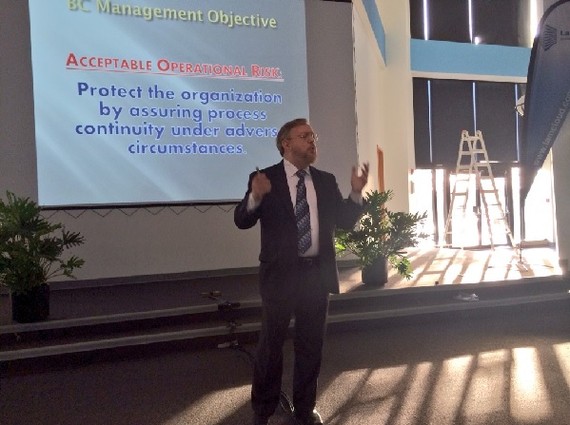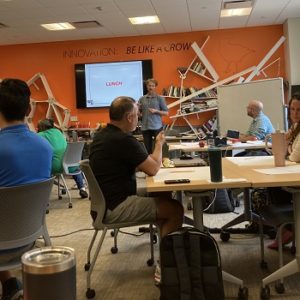Business Continuity and Alternate Workspaces Discussed at Lam Cloud Open House

At the Lam Cloud Open House in November, attendees were treated to a couple of talks by experts in the disaster recovery/business continuity field.
While Lam Cloud’s building in Cranbury is designed for numerous data-related tasks, including Internet colocation, it will be put to good use by companies that need temporary quarters with resilient connectivity after they suffer from a business disaster, speakers said.
We covered the Lam Cloud open house here.
Marvin Wainschel, founder and CEO of McWains Chelsea (Morristown) and author of the book Knowledge at Risk, aimed his work area recovery talk at the business continuity planners attending the open house.
Work area recovery is the need for space for people to go in the event of a disaster. In the industry, a disaster is defined as something that forces you to move to a different location, he said.
He pointed out that business continuity planners are risk managers and that risk doesn’t mean that all possibilities are covered if something goes wrong. “We strive for acceptable, operational risk … Our concern about risk is that we have continuity in business processes. That is what we are striving for.”
The most important asset to a company is people, he added, and people need a place to work. “When we write recovery plans, we think about protecting public assets, protecting people” with hard hats and communications plans to allocate responsibility, he said.
After a disaster, there is an acceptable downtime for business processes, he said. Not every process can be brought up immediately. However, companies need work areas before they can bring up processes, because people are needed to implement plans, he said.
Various options are available for workspaces, he indicated. Sometimes companies make reciprocal agreements with other companies. The firms build a recovery site together and the companies in that agreement can use the site when they need it.
“You can leverage other company locations, such as an empty warehouse, that is provisioned as a recovery center,” with the proper network capabilities and power backups. “Or, some of your people may be able to work at home,” he said.
Or a company might want to use trailers in the parking lot so your people don’t have to travel to an alternate location.
A company can use a site such as the Lam Cloud facility, he said, which is a great alternative, especially for processes that have to be back on track almost immediately.
Wainschel advised companies to spend enough money “in the analysis and planning phase so they can keep the numbers low in the implementation phase.”
Following Wainschel, Paul Sullivan, vice president and general manager, Agility Recovery (Charlotte, N.C.), discussed valuable lessons learned over the last year and best practices going forward.
Since the open house, Lam Cloud announced it has partnered with Agility Recovery to deliver a comprehensive disaster recovery and business continuity solution to customers in the New Jersey /New York metro market, as well as elsewhere.
“Disasters don’t have to be a Sandy,” Sullivan noted. They happen every day. They can be as innocuous as a sprinkler system going off because there is a fire on the floor above you, he said.
Loss of power has the biggest impact on companies during most disasters, he added.
“Everyone has a work-at-home strategy, but that didn’t work in Sandy, because there were eight million people without power … Power not only affects your business, it affects your people. You have to look at how to recover your power if you don’t have the people there to help you.”
One of the first lessons learned, he said, was: Don’t put your network infrastructure or your power in the basement.
Prepare your employees, he advised. During Sandy, it was clear that employers didn’t make sure that their people were prepared in both their home life and their work life. “If you take care of their home life, people will take care of the business for you,” he said. That includes gifting preparedness kits that will take families through seven days, he said.
“Use your capability to recover as a selling tool,” Sullivan advised. “Tell people you have this capability. They’ll know you are always going to be there.”
While there are little or no cost measures a company can take to mitigate risk, there are always going to be some high cost items that cannot be mitigated. “But you can insure it, remembering that insurance, in most cases, is going to help you rebuild your business; it is not going to recover your business.”
When you have a plan in place, make sure your employees know what’s in the plan and know what to do, he said, because if they don’t, you are setting yourself up for failure.
Also, far too many times, companies don’t think about how they are going to get their employees to work in the case of a regional event, Sullivan said. Put a plan together to carpool or hire a bus, so you have some way to get people to the environment where you want to restore your business, he said.
Companies should think about putting a fuel program in place and bring in portable gas stations on site.
From the business perspective, understand your supply chain and find out if there are backups available. “Challenge them to have a plan and actively participate with them to create one if they don’t,” he said. If you outsource IT, think about the backup capability of the places that you outsource today.
Don’t have a single vendor for your cellphone, Sullivan advised. Split up your service so that you are not relying on one particular carrier, should there be a disaster event.
Also, don’t have a single person as your spokesperson or decision maker during a disaster. Have a backup just in case the first designated person can’t function. “You’ve created a single point of failure by one person being in charge.”

